Now is the winter of our post-lockdown life...
…looking more uncertain than ever.
Since the beginning of Italy’s lockdown, in March 2020, I have done my best to report what that lockdown was really like, and above all what it meant for the world in general, especially after COVID19 is gone. At the end of June I stopped, for several reasons. One was that the world had somehow catched up with Italy, and what was happening in the US and Brazil made whatever I could tell from here look lame in comparison, or so I thought. Another was the mere need to recover, to take one step back from it all. A third reason is that I would have repeated myself: much of what I wrote months ago about what would happen (or not) here and elsewhere after the “first wave” seemed to be correct, so no need to repeat it, right?
One month ago I finally came out of hybernation. However, I needed some more time before writing again about how COVID19 has turned Italy into a giant, half-conscious socioeconomic experiment that doesn’t know if it wants to succeed. Now is that moment. Please share this, and the posts on the same topic that will come right after the Sept. 24th elections.
Now is the winter of our discontent…
Made glorious summer by our own mental exhaustion…
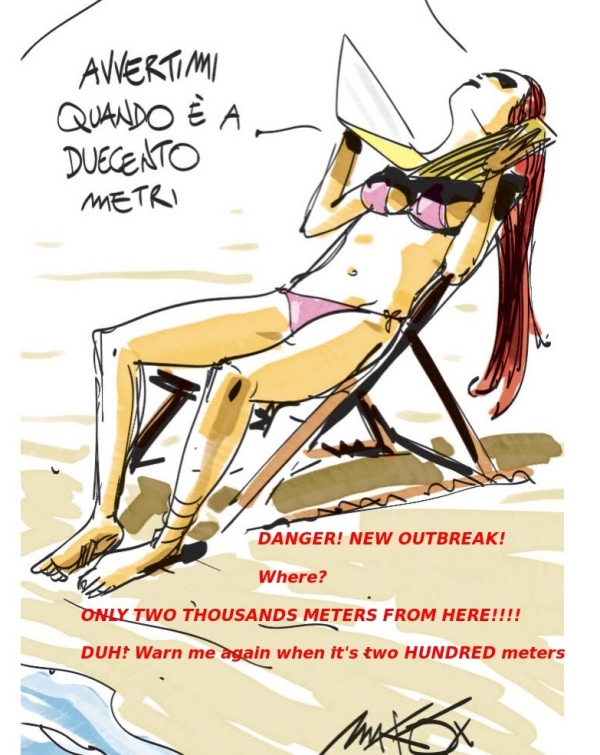
<u><em><strong>CAPTION:</strong>
<a href="/img/post-italylockdown-attitude.jpg" target="_blank">Part of a great strip by italian cartoonist Makkox. I cut most of the original dialog, but added the full English translation</a>
</em></u>
To know what Italy was like immediately after the end of the lockdown, please do read this other post of mine, as it is a useful prelude to this one. At the end of June, it was already clear that, albeit the virus was not locking Italians at home or filling ICUs anymore, it was NOT over, no way. If anything, it seemed clear that without the lockdown things would have been much worse, and that mass vaccination, if possible, is very unlikely to happen before next spring anyway.
Two months after that post, most Italians have not understood these facts yet, or keep consciously or inconsciously forgetting them.
Many safety rules have been issued on these matters, from the Senate down to the smallest city council. Some are obvious and due, starting from masks. Others, especially at the lower level, seem all inspired by the same basic principle: “There! Now that you have read this, if you get sick it’s not my fault, sue somebody else”.
In the streets, however, most people just routinely ignore the rules about proper use of masks, or continuous sanification of hands and public surfaces. Thanks heaven, unlike in the US this is not a political issue at all. There are real, and noisy, “COVID19 negationists”, but they are very few and scattered across all political parties.
In a few cases, this neglect of rules is due to actual IQ or literacy issues, but by and large it is simply exhaustion: it is the consequence of being too mentally tired to also bear the load of those rules, on top of recovering 2+ months of partial segregation and, very often, having more debts and less work than BC (Before Coronavirus).
This is why Italians “took beaches by storm”, and, in July, were buying half the masks, and 90% less sanitizing spray than at the beginning of lockdown.
True story: the last day of July I dared return to my usual barber shop for the first time since February (because boy, did I need it…). For my whole life, I have just walked into those shops whenever I felt it was time, and waited for my turn. This time, I had to book my haircut by phone, which for some reason felt more depressing than having to go there masked.
When I walked in, masked, I found the staff wearing their masks below their chins, and immediately asked “why aren’t you wearing them?”. They all put them on, while one of them (“Barber Joe”) courteously explained that “of course, but what is important is that YOU wear the mask, for yourself”. Then they did make a very professional job of giving me just the haircut I wanted, while properly masked (that is, with decreased field of view!) and without ever moving my own mask. Then…

<u><em><strong>CAPTION:</strong>
<a href="https://napoli.repubblica.it/cronaca/2020/03/10/news/coronavirus_campania_la_regione_chiude_negozi_di_barbiere_parrucchiere_centri_estetici_-250845033/" target="_blank">This could have been me, having a haircut (image source: Repubblica)</a>
</em></u>
While I was paying my bill and giving my phone number for tracing, as required now, another customer walked in, maskless. The staff said nothing, let him sit unmasked and the following dialogue took place over the shampoo:
Same “Barber Joe” of before: How it’s going?
Customer (evidently a local restaurant or hotel manager): Personally, OK, I guess. Work-wise, it’s REAL bad. There is just too few tourism around.
Me (in my head only, because I couldn’t wait to leave the place): One main reason why there still is “too few tourism” (that is, not enough money or confidence to go spend it on holidays), is exactly this carelesness of yours. This is what keeps R0 over 1, and the reason why I may just buy a hair trimmer next time.
Status of the pandemic
Too much reporting remains as meaningless as it was in June, both in Italy and abroad. Personally, I find the two charts below, published on FB groups in mid-August, still adequate to summarize my very own, personal understanding of how Italy did over the summer, and is still going. One is the weekly average of new daily cases, which in the first half of August was low but increasing, in several regions:
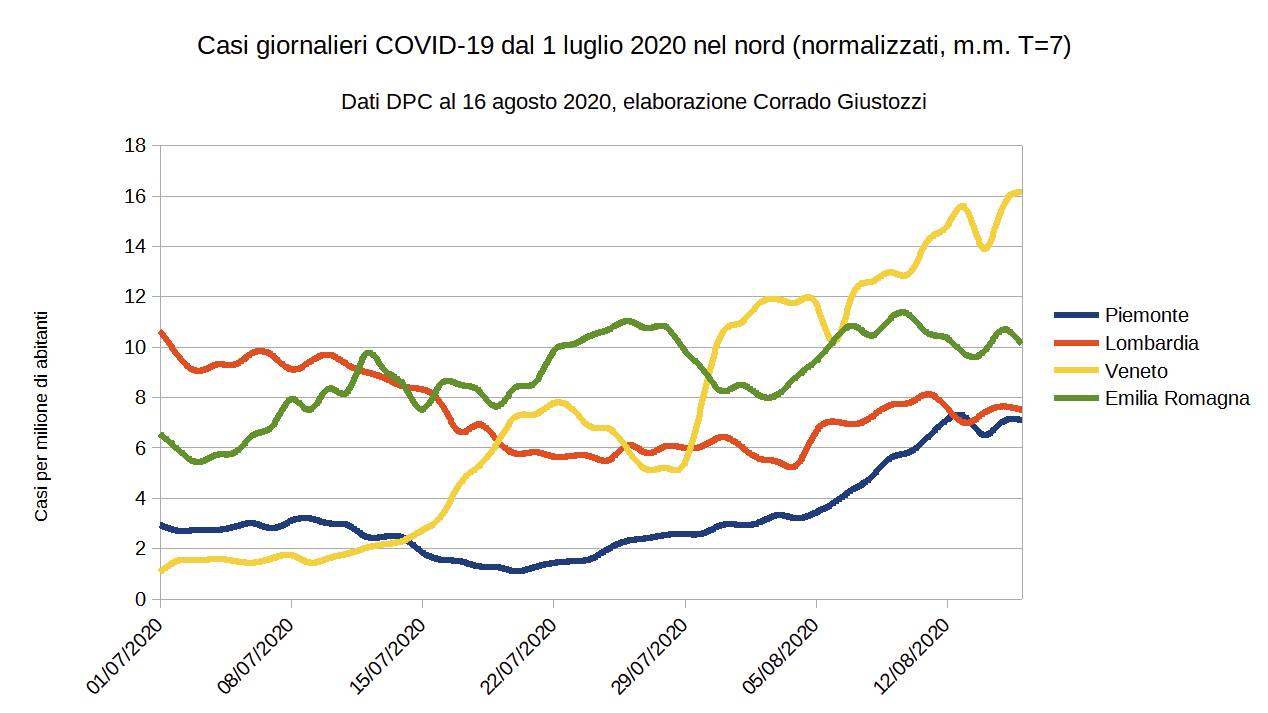
That general trend continued, and as of September 6th, the nationwide R0 factor was still greater than 1. On September 3rd, there were 38% more COVID patients admitted to hospitals, and 62% more ICUs patients than the week before. Many people and media blame for all this the “thoughtless morons who just had to go dancing every night, or vacation in high-risk countries”, but I don’t think this is a complete explanation.
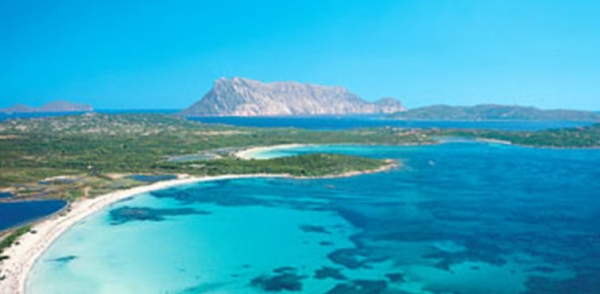
<u><em><strong>CAPTION:</strong>
<a href="https://www.agi.it/dar01/news/2020-08-24/coronavirus-sardegna-movida-9479380/" target="_blank">Coronavirus was imported in Sardinia by tourists. Almost all local residents who are infected work in discoteques or other tourist businesses, said a local healthcare manager</a>
</em></u>
Indeed, many new contagions are due by Italians returning from Sardinia, or from abroad (many more than from immigrants, for sure). Frankly, I would not have complained if every Italian who took a plane to Ibiza, Mikonos or similar places this summer had been sent (and fully billed!) to a 2-weeks mandatory, in-airport quarantine, the moment they got off the plane.
However, as I said above, it is the brains of all Italians that have snapped. For what is worth, my own feeling is that the average age of infected people has decreased simply because youngsters (including teenagers who never went farther than the closest beach, or city park, but always unmasked) have always spent more time than their seniors gathering in places much less controllable than homes or workplaces..
All this is obviously not good, but the situation may be probably less worrying than that number alone says. This other chart, drawn in late July, helps to explain why I hope so (again: take this as purely qualitative, mile-high observations!):
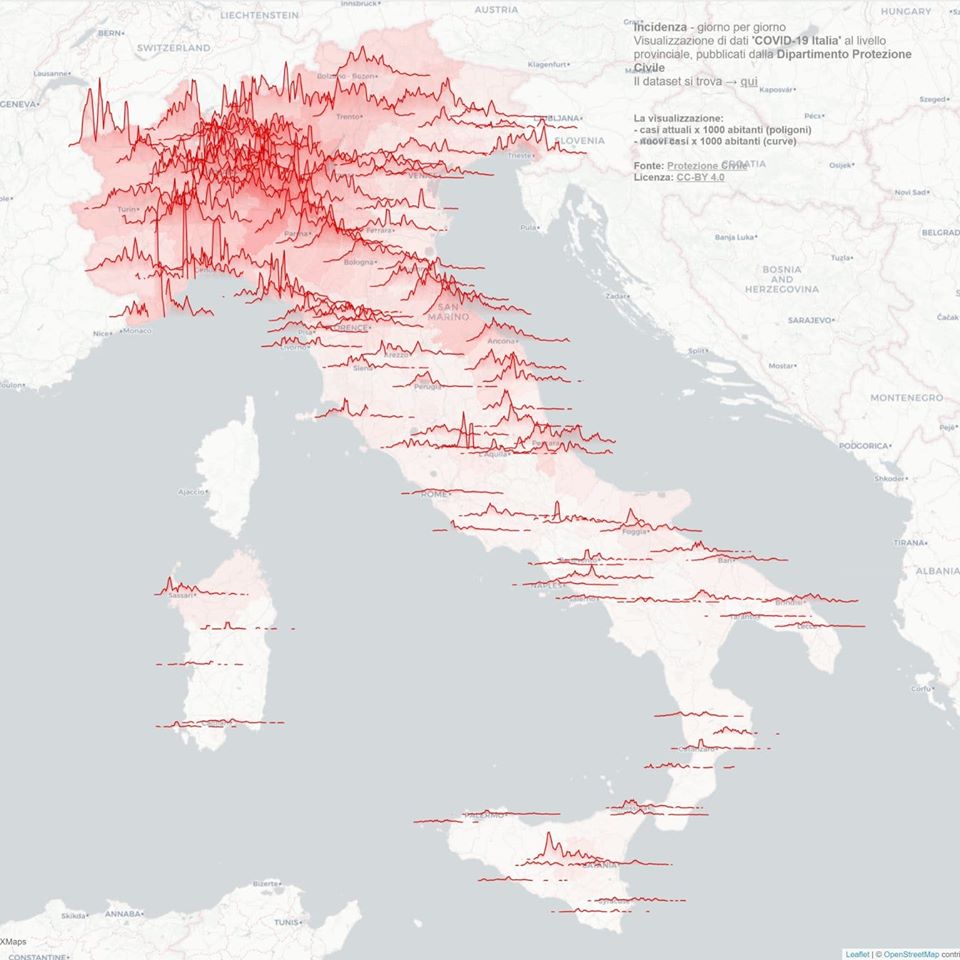
Here, the shades of red indicate the number of cases per thousands residents when the chart was drawn, in each province of each italian region: darker shades correspond to higher percentages. The lines, instead, show the trend of new cases, in each province.
That second chart clearly shows that things vary a lot from province to province. This seems a confirmation that in the future it could be sufficient to declare further, maybe even stricter lockdowns, but at the province or city level only, without halting the whole country.
Another reason to say this is that the italian healthcare system, while still far from perfect, is doing much more testing and is much more knowledgeable, and hopefully much better organized to avoid ICU collapse than it was in February. What is still groping in the dark to find a real, lasting way out of this mess is the rest of the country.
Daily life, now and tomorrow
Consumption at the end of 2021 should be still 3% less than in 2019. Catholic organization Caritas reports a 34% increase of “new poors” lining up at its soup kitchens, as well as an increase of violence and abuses in families. Fear of contagion has decreased church attendance.
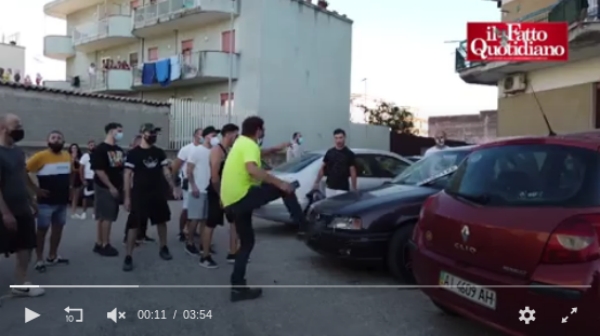
In late June, some italian residents of the town of Mondragone went to the streets, to destroy cars and vans of the Bulgarian farm laborers, despised as plague-spreaders because of an outbreak in their community that, at least partly, is due to how other italians force those immigrants to work and live.
Women pay a higher price. The duty-free shops in the two airports of Rome employ approximately 300 people. When some of them could reopen, in July, management said sales forecasts were too low to make everybody work more than 8 days per month. However, sources tell me that almost immediately they had to rewrite the whole rotation schedule, because about 100 people said they were not ready to come back.
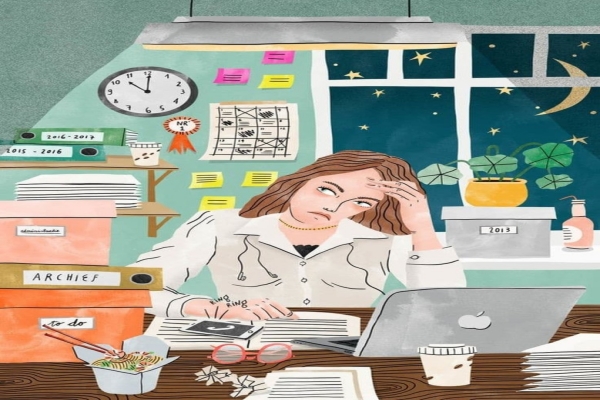
Why? According to the same sources, one or two of those employees maybe never really needed a job (“He only shows up for pocket money and to look adult, who pays his rent are and remain his parents”), a score or two have concrete medical reasons (diabetes and similar) that allow or require them to not work “facing the public”. But it is highly likely that the great majority of those hundred people are women who, even if they had just lost at least two months of salary, have kids or elders that nobody else could look after. Not for what they could pay by working only 8 days per month, that is.
Fact is, when the lockdown officially ended on May 4th, of all the Italians who could return to work that day only 25% were women. In general, lockdown meant less (paid) work and more stress for women.
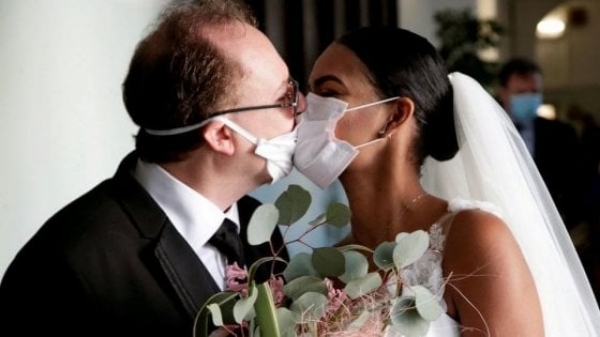
On a less depressing note, starting in July, newlyweds can kiss each other again, even if everybody else must still wear masks and keep physical distancing.
Schools. Enough said
Italian schools will reopen less than ten days from now, on September 14th, and this is by far the single biggest factor of chaos, uncertainty and debate right now: millions of people spending many hours in environments and contexts, be they classrooms or public transit, where any rule is much, much less enforceable than in workplaces? What could possibly go wrong?
As I write, only tiny handfuls of parents across the country have received enough information, and enough confidence that will be accurate, to be able to tell “this is how my kids will start school, and live it until Christmas”.
The only certainties are those in this list of real quotes from my own personal and work contacts:
- Italian teachers are the oldest of the world, with an average age around 52. A significant number is “fragile”, that is has “pre-existing conditions” such as (diabetes, hearth or respiratory issues…) that grant them the right to work from home, if they so ask. So far, only 300 teachers have asked this exemption. However, the procedures to hire the thousands of new teachers that would be needed for smaller classes have not started yet
- When those teacher selections will finally happen, many thousands of them will have to gather in a few buildings all over the country, then go back to their home towns. Unless they ALL get tested on the same day in those buildings, bad things will ensue
- All of the above makes the reliability of any class schedule pretty low, to be polite. Indeed, on September 4th, 68% of parents had not received yet official, detailed information from their kids' schools. Stop a second to consider what this means for the overall economy
- No mandatory rules, or resources exist, to test all teachers periodically, or to take everybody’s temperature every morning at the school’s gate, that is in reliable, consistent conditions.
- If physical distancing of at least one meter in classes were really enforced across all schools, approximately one million of students would remain in the streets
- In almost all cases, the bandwidth available to schools and their pupils is much less than what would be needed to make decent online, interactive lessons. Much, much less
- Going back to online lessons may be OK in high school and universities, that is for students at least 14 years old. Maybe
- But for younger students, it is unbearable. No way. Primary (6-10 years) and “intermediate” (11-13) students will just go real sociopathic with just screens (when they have them, of course) instead of physical company. That’s as sure as hell
- Think of the lucky students of the primary schools that will be able to enforce all the rules properly: They will never touch each other, never share pens or cookies, never play with the same ball or Legos together, unless with gloves… Oh, and to decrease contacts, they will also be grouped into permanent “bubbles”, that is class sub-groups that will interact as little as possible with each other. Those kids are likely to turn sociopathic anyway, aren’t they?
All this is why, on September 5th, there is in Rome a growing “movement” to shift the opening of schools to September 24th, as some regions have already decided.
So far, the least-worst plan, and the most likely to actually happen as intendend (barring more lockdowns) is the one I’ve heard from a nephew of mine about her own high school in Rome: first, they calculated how many students of each class could sit in their usual classrooms, at a distance of at least one meter, and found that, on average, each class had four students more than allowed. Then, they put webcams in all those classrooms, and connected each of them to a separate, previously unused room in the same building, that was then furnished with desks and monitor. In this way, all students could go to school as usual every day, and the only change would be that every day four (or less) different students of each classroom would follow lessons from the “attached” room.
Of course, many schools do not have spare rooms at all, and tricks like that won’t do nothing to avoid students dangerously crowding on buses and subways: that is another issue that right now everybody is trying hard not to think about.
Paradoxically, this whole mess may be part masked, part rescued, at least temporarily, by a separate potential “bomb”, just one week after it starts. By longstanding tradition, italian public schools double up as polling places, and the administrative elections for many regions and thousands of towns that should have taken place in May were moved, courtesy of the lockdown… to September 20th.
Therefore, what most schools, not to mention the Ministry of Education itself, will actually do is:
- a 4-day “general drill” from September 14th to September 17th, then…
- close and figure out what to change until September 22nd to let voting and vote counting take place
- implement the changes after the 22nd, taking advantage from the fact that most of the country will be busy howling over the election results, and their effects on the pandemic…
The economy, you say?
GDP in the second quarter was 9% down.
Announcements that foreign tourists are returning feel good, but don’t tell yet how many hotels or restaurants those tourists found closed for good, or how much money they could spend on vacation, compared to last year. Overall, it looks like italian tourism will end 2020 with losses for 100b Euros, and 65M less presences.
For now, the only things that seem sure are that inequality increased also in tourism, internal competition is fierce, and local administration are scraping the bottom of the creativity barrel, in order to “get our lives back” without being sued:
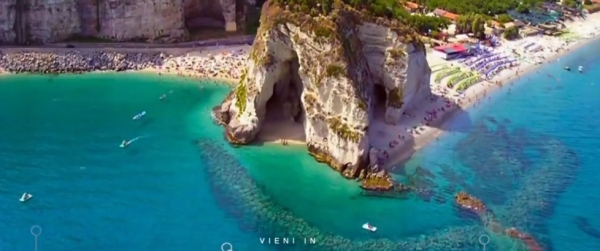
- about 50% of Italians have not gone on vacation this summer, but another 40% will go twice, even if only in Italy, and for short periods
- The city majors of Locride, a district of Calabria (the toe cap of the boot), teamed up to fund a spot whose core message is “Why risk COVID19 in Northern Italy, that is highly polluted anyway? Dear Italians, come to us!"
- the region of Emilia-Romagna, instead, allowed the [traditional couple dances to resume in dancing clubs but… “only between cohabitants”
The olive oil sector, a flagship of Made in Italy agrictulture, lost 2 billions Euros between closed restaurants and diminished exports. In March, in Rome alone there were already more than 950K square meters of empty office spaces, most of them because of wrong planning, not COVID19. Knowing the urban history of Rome, the risk now is that they will not be restructured, or repurposed, but abandoned to build new buildings “best suited to the new normal”, that is likely to be emptied once COVID19 is over.
In addition to all the people furloughed, or on unemployment insurance, or just laid off, about 54K jobs with temporary contracts were not renewed between March and June. In June, riders went to the street to denounce how they are still without rights, after serving the country during the lockdown. Taxi drivers are “more or less starving”.
Overall consumption fell 57% in May. The total load on the national power grid (see yellow line below) fell 30% when the lockdown started, and one month after its end was still 12% below the pre-pandemic level:
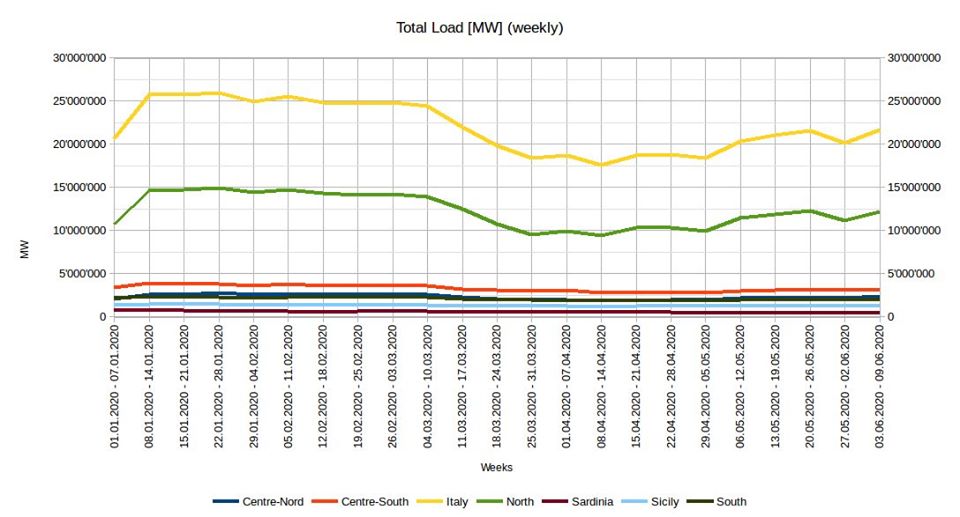
On average, Italians has lost 2.5K Euros each, but re-discovered drive-in cinemas, and those who do have money can enjoy interest rates for house mortgages under 1%.
Not bad overall, is it? Especially when you consider that this is the status with most companies still forbidden by decree to lay off many thousands of people (but only for a few more months), or getting closer to bankrupt because they cannot pay each other anymore.
A (hopefully) once-in-a-lifetime to fix the tax system
True story: in Italy there are about 3500 dance clubs. This August, they loudly complained that government restrictions on their activity will make the whole sector lose about 4 billions Euros this year, that is about 1.1 million Euros per club. Fact is, in 2019 those same 3500 discoteques declared 16 millions Euros, that is around 4600 Euros each. Over the whole fiscal year. By now, you too are surely asking yourself:
- Why would anybody run a business that yelds only 4600 Euros of profits over 1.14 millions in revenues? How could they?
- If the 16 millions are the revenues of 2019, instead, could the clubs please explain how COVID19 could ever make them lose 250 times more money in just one year?
Bitter smiles aside, this is relevant because (if those numbers will be confirmed) dancing clubs are only the category that got caught first (or the only one dumb enough to make certain claims without re-reading their last tax returns).
The real issue here is that, in Italy, tax frauds is widespread, hard to discover and hard to prove, because of how uselessly (or deliberately) complicated the rules are. The amount of taxes can also encourage, or force, fiscal frauds, of course, but that is a separate problem.
It would have been great if Bruxelles had told Rome “you can have all the money you want, and spend it as you want… but only after you have made your tax code ten times smaller, and easier to follow”.
Meanwhile, Europe is changing
COVID19 has reboot the worldwide passport market, leading for example Cyprus to sell UE citizenship to criminals, super-rich and politicians”.
Back in March, many EU countries, including Italy, felt China was helping them much more than the EU, or the US. Now, that situation has changed:
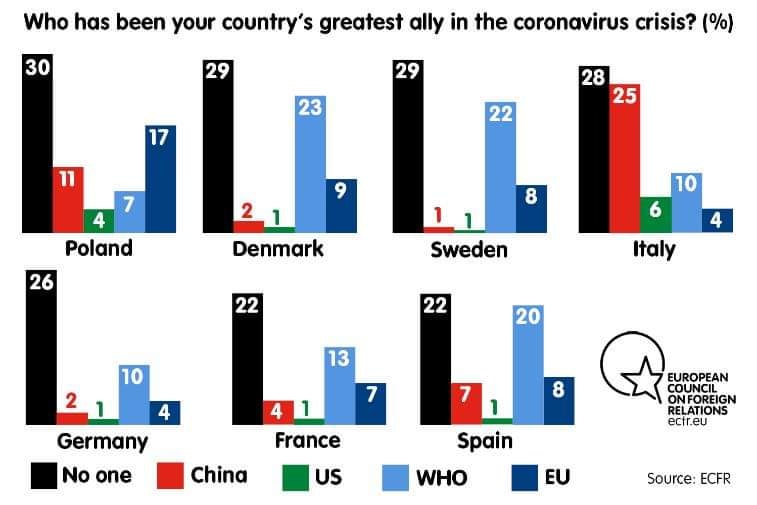
“Nobody” is the main ally, and one that will surely carry some weight in the next EU parliament elections.
On July 23rd the EU reached a 390B Euros budget deal to face COVID19, that is relevant for at least two reasons. First, it does not make concrete respect and enhancement of a foundation of the EU vision, that is rule of law and civil rights, a prerequisite to access those funds. This is a big deal, because that foundation, and the size of its internal market, are among the main things that make EU stand out, with comparable weight, alongside US, China, Russia…
Second, but probably unavoidable: in order to make COVID19 recovery possible, the deal heavily cuts many ambitious, and in the long term essential investment plans, starting from those for adaptation and contrast of climate change, and research and healthcare. Smaller plans have been frozen, or canceled. This has been the price to pay to allow the most innovative part of the plan, that is a fiscal transfer towards the states most hit by COVID19 (Italy should receive 80 billions Euros), without vetoes on how part of that money should be spent.
For what is worth, I saw EU officials comment that (synthesizing) “these cuts to european-level projects de-facto nationalize the european budget, and are not good news for whoever aims to a greater integration, or coordination, of EU Member States”.
Now we will have to see how the European Parliament, that explicitly requested a link between funding and rule of law, and is the only EU institution directly elected by citizens, will react to the deal, and contribute to its implementation.
Final request
All my reports about COVID19 in Italy also contain plenty of notes, data, food for thoughts and calls to action about the worst thing that may happen worldwide, that is… returning to business as in 2019 as soon as this mess is over. Please do [read, give feedback and share them](/tag/coronavirus] as much as you see fit, and if you can… thanks in advance for supporting more reports, as well as my other work and blogging[/about], by donating, or other means.
Who writes this, why, and how to help
I am Marco Fioretti, tech writer and aspiring polymath doing human-digital research and popularization.
I do it because YOUR civil rights and the quality of YOUR life depend every year more on how software is used AROUND you.
To this end, I have already shared more than a million words on this blog, without any paywall or user tracking, and am sharing the next million through a newsletter, also without any paywall.
The more direct support I get, the more I can continue to inform for free parents, teachers, decision makers, and everybody else who should know more stuff like this. You can support me with paid subscriptions to my newsletter, donations via PayPal (mfioretti@nexaima.net) or LiberaPay, or in any of the other ways listed here.THANKS for your support!